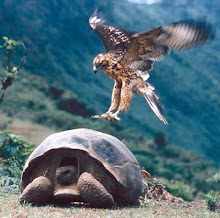Darwin's Theory of Evolution
In a recent class we were able to apply our knowledge and try to become analytical with it. Professor Jimenez brought 8 turtles (one probably weighing over 15 lbs). The catch was that we had to distinguish between these which were real turtles and which tortoises. It was very interesting to hold these turtles and recognize features in them that distinguished them from others. Some had long nails which meant that they were at digging, others had long tails, while some barely had one. If they had a sharp mouth this meant they good at cutting their prey and different things. For me the most interesting one was the box turtle. The most entertaining feature was the ability it had to hide its head inside the shell. The shell could completely close so it could stay safe from any threats. For this reason its name. The project was to understand how most of these species lived in different areas. Some had to live in forests, other near water and some in the mud. However they were all turtles.
This is where Darwin inspired his theory, in the Galapagos Islands. He noticed how different turtles required different features and abilities in order to survive. The following is a key description of Darwin’s main points on evolution and his idea of natural selection:
• A species is a population of organisms that interbreeds and has fertile offspring.
• Living organisms have descended with modifications from species that lived before them.
• Natural selection explains how this evolution has happened:
— More organisms are produced than can survive because of limited resources.
— Organisms struggle for the necessities of life; there is competition for resources.
— Individuals within a population vary in their traits; some of these traits are heritable -- passed on to offspring.
— Some variants are better adapted to survive and reproduce under local conditions than others.
— Better-adapted individuals (the "fit enough") are more likely to survive and reproduce, thereby passing on copies of their genes to the next generation.
— Species whose individuals are best adapted survive; others become extinct.
http://www.pbs.org/wgbh/evolution/educators/course/session2/explain_c_pop2.html


0 Comments:
Post a Comment
Subscribe to Post Comments [Atom]
<< Home